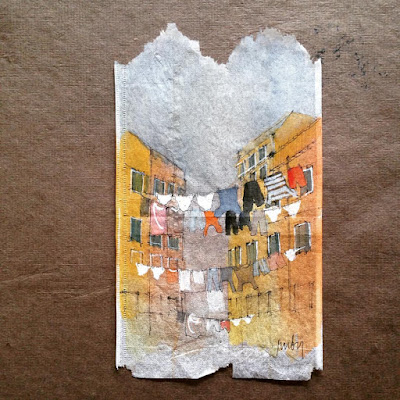Pekka Hämäläinen wrote one of my favorite books of American history,
The Comanche Empire, so when his new book came out I eagerly ordered a copy.
Lakota America (2019) is a more narrowly political book, with less ethnography and ecology, but shows the same profound scholarship and perhaps even greater insight into past societies and events. It is not an easy to read but after finishing it I know things I did not know and understand history in a new way, which is the greatest praise I can give a historian's work.
Sioux history begins in the late 1600s, when they lived mostly in what is now Minnesota, along the boundary between the forest and the tallgrass prairie. For the first century of their history we have two kinds of sources: the accounts of French traders and soldiers and the Native records known as winter counts (above). The oldest of these reach back to the very early 1700s. They are series of pictographs, usually one for each year, written in a spiral pattern. They require interpretation, but by anchoring oral tradition to particular times and places they create a generally trustworthy record of how some Indians saw the major events of their lives. Hämäläinen makes much use of them to show how differently the world sometimes looked from the Native perspective.
From those first mentions, and probably before, the Sioux were a numerous and powerful people. Hämäläinen makes this one of his themes. The Sioux conquered other tribes because there were just more of them, 20,000 or so when tribes like the Kiowa, the Crow and the Pawnee never numbered more than 5,000. The Sioux were not politically united. They were divided into seven tribes: Yankton, Yanktonais, Mdewakantons, Sissetons, Wahpetons, Wahpekutes, and Lakota. Their name for themselves is
Očhéthi Šakówiŋ, the Seven Council Fires. The Lakota, who in the 19th century made up a majority of the Sioux, were further divided into seven bands, including the famous Hunkpapa and Oglala. But they saw themselves as one people and there was no civil war among them (although there were plenty of murders), and they generally allied to oppose outsiders. To Hämäläinen the secret of their success was the institutions, rituals, vocabulary and other cultural practices they used to bind such a large group of people together in a rapidly changing world. The identity of being Sioux was powerful and appealing enough that it endured and grew despite the turmoil the people lived through. In that era of frequent, deadly epidemics it was also vital for large tribes to incorporate newcomers into their ranks, and the Sioux also excelled at this, rivaled perhaps only by that other great warrior people, the Iroquois.

To me the most striking thing about plains Indian life is how new it all is. The plains Indians as we know them did even really exist until they had horses, which did not reach the northern plains until around 1700. Based on the winter counts, the Sioux got their first mounts in the 1740s. Horses did not breed very well in that land of bitter winters and frequent droughts, so it took decades for the Sioux to build up herds big enough to support them in a life on the plains. The first depiction of a mounted raid in a Sioux winter count comes from 1757. It was the Lakotas, always the westernmost of the Sioux tribes, who took the lead in this, and over the next fifty years they gradually became the dominant group within the broader Sioux brotherhood. In the 1750s the Lakota began moving onto the plains, but it took a long time for them to become true plains people, rather than inhabitants of river valleys who sometimes ventured onto the plains to hunt. From the booming fur trade with the French they acquired guns, although they continued to use the bow and arrow as well right down to the 1870s.
With horses and guns the Lakota pushed westward to the Missouri. This was an act of war, for other Indians already lived there: horse-riding tribes like the Kiowa and Cheyenne and also farmers who built villages along the rivers, such as the Mandan and Arikara. Hämäläinen calls the Lakota world that developed an empire, based on dominion by force over all those they encountered. Some tribes they drove off the plains entirely: Omahas, Poncas, Otoes, Iowas, and more, who fled toward the lower Missouri and the protection of European soldiers based in St. Louis. The Lakota destroyed several river villages, slaughtering or enslaving their inhabitants, until the cowed river people accepted their overlordship. The Arikaras became serfs, forbidden from leaving their villages and forced to trade their corn and beans to the Lakota at whatever price their masters felt like paying; the Lakota reminded them of who was in charge by regularly taking Arikara horses and women and daring them to complain. All other Indians, they told one British delegation, "were their slaves or dogs" (89).
When Lewis and Clarke met them the Lakota dominated a 1000-mile stretch of the winding Missouri River, from the White River to the Knife. These Americans were shocked by the way the Lakota dominated the village Indians and called them "savages," but they also figured out that it was the Lakota who held the power. For the next 70 years the Lakota were the focus of US policy in the region. One of Hämäläinen's themes is that while we imagine the Lakota and the US as rivals, they were for a long time allies, and the US government helped the Lakota solidify their vast plains empire. Trade, gifts, and eventually rations distributed at Indian Agencies helped make the Lakota stronger than other Indians, allowing them to extend their power farther and farther west.

Pushing westward from the Missouri the Lakota reached the Black Hills. The Black Hills were a great resource for any people living on the northern plains, for often these elevations caught rain when the rest of the country was dry. They were also visually stunning and, all the people who lived around them thought, spiritually charged. It was in the Black Hills, the Lakota later said, the the Great Spirit first breathed life into humans. Through the first half of the 1800s the Lakota world stretched from the Black Hills to the Missouri. But they did not stay even there. As more and more white men moved up the Missouri and the Platte, the eastern buffalo herds thinned, and the Lakota responded by shifting farther west, waging war against the Crow, Utes and others for the lands around the Yellowstone, Powder, and Bighorn Rivers. As late as 1875, just two years before the war that broke their power, the Lakota were conquering lands along the Yellowstone and Bighorn Rivers from the Crow and Utes; winter counts from 1871-1875 have much more about fights with other Indians than the looming crisis with the US government.
Eventually, of course, the Lakota were broken and forced to settle on reservations that were tiny compared to the vast empire they had controlled just a few years before. It is a sad tale of ecological devastation and human loss, of people killed and a whole way of life exterminated. But the Lakota of course have endured and still remain, their language and traditions much stronger than those of most Native American peoples.

Starting in 1851, the US government signed a series of treaties with the Lakota that gave them rights over vast areas on the plains. The most important was the Fort Laramie Treaty of 1868. In the map above, the blue area is the Great Sioux Reservation as the treaty defined it, which was given to the Lakota as their property in perpetuity; the other areas were not granted so fully but the Lakota were guaranteed the right to hunt on them so long as the buffalo herds endured. In the south, that did not last very long, but North America's last great bison herds were found west of the reservation toward the mountains. This treaty is, so far as I understand it, still in force, and in 1980 the US Supreme Court found that the Black Hills in particular had been unfairly stolen from the Sioux and Cheyenne. They ordered the government to pay compensation. The government offered $122 million, which the Indians refused, saying that they wanted their sacred land, not cash. Hämäläinen quotes one Lakota as saying, "It's always been ours. It will always be ours." (389)

What are we, in the 21st century, to make of these claims?
One of the Sioux winter counts records the year when they first set eyes on the Black Hills; depending on how you work the chronology, this might be any year from 1765 to 1776. This was at least 22 years after two French traders named François and Louis de La Vérendrye visited the Black Hills, which happened in 1743. It is also at least 85 years after a certain Robert Bedell landed in New York, founding the North American branch of my family, which in turn is about 60 years after certain of my other ancestors landed at Jamestown. When my ancestors reached the Chesapeake Bay country, where I now live, the Sioux were still in Minnesota, and harvesting wild rice was much more important to their culture and economy than hunting buffalo. Most of the online histories record that the Lakota conquered the Black Hills not long after they discovered them, but Hämäläinen thinks that did not happen for decades and that the Black Hills were not really Lakota territory until around 1820.

The Lakota conquest of the Black Hills and indeed their whole plains empire did not happen in the distant, misty past. It was recorded as it happened, both by the Native compilers of winter counts and Euro-American observers. It was accompanied by great violence against other Native Americans, some of whom had claims to the Black Hills or the Missouri River country that went back centuries or millennia before the Lakota arrived on the scene. It may well be that modern Lakota have among their ancestors Mandan or Arikara people who had long lived in this land, but that is not how they defend their own claims; they defend them as Sioux.
I do not say this to refute Lakota claims; after all the US government signed those treaties and then flagrantly violated them. My point is that the distant past is not always a very good guide to what we should do in the present. The case of the Black Hills shows that it does not take centuries to make a place a sacred home. Under the right circumstances it takes only a generation.
Any given place may be the sacred home of several different peoples. If the Sioux did manage to reclaim the Black Hills I suspect they would then be challenged by other Native Americans – Crow, Blackfoot, Cheyenne – who were in the Black Hills before them. Who would adjudicate those claims? And what, meanwhile, about Euro-Americans whose ancestors came to the Black Hill to mine gold in 1875, and whose families have therefore been in the Hills for twice as long as they belonged to the Lakota?
I am skeptical of all claims that one place belongs to one people; these claims are the root of wars around the world, most notably in Israel/Palestine. My goal is always for all of us to live together, as best we can, regardless of whose ancestors did what to whose. That is past. What counts is the future, and how we can make it better for everyone.




















































